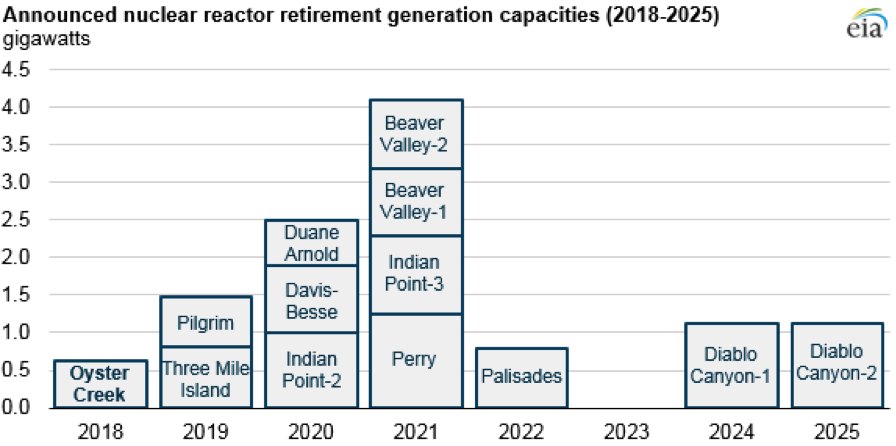Competition from natural gas and renewable energy has forced the retirement of existing nuclear plants in the United States. Out of the 66 facilities currently operating in the United States, 24 nuclear plants are either scheduled to shut down or will likely not make a profit through 2021, according to a report released earlier this year. The at-risk plants total 32.5 gigawatts or more than a quarter of the entire nuclear fleet. According to one estimate it would cost about $1.3 billion annually to keep these plants operating. Certain state governments (New Jersey, New York, and Illinois) have subsidized some of their struggling nuclear plants to save jobs and provide sufficient power to keep the lights on. In April, the New Jersey state legislature passed a law to provide a $300 million annual subsidy for the state’s remaining nuclear power plants. However, in states not offering bailouts, nuclear plants are closing. In August, FirstEnergy announced steps to prematurely close three of its nuclear plants in Ohio and Pennsylvania.

Nuclear Power in New Jersey
The 625-megawatt Oyster Creek Nuclear Generating Station, located 50 miles east of Philadelphia in Forked River, New Jersey, was retired on September 17, 2018, after operating for 49 years. The plant came online on December 1, 1969, making it the oldest commercially operated nuclear power plant in the United States. Despite the Nuclear Regulatory Commission (NRC) granting Oyster Creek a 20-year license renewal in 2009, the plant owner and the state agreed on a retirement date of December 31, 2019. But the closing date was accelerated to coincide with the plant’s fuel and maintenance cycle. A major reason for its early retirement is an estimated $800 million to install cooling towers to meet new environmental standards In 2017, Oyster Creek generated 7 percent of the state’s electricity (5.4 million megawatt hours)—almost twice as much as all of the solar photovoltaic systems in New Jersey.
Oyster Creek is the sixth nuclear power plant to retire in the past five years. Before Oyster Creek’s retirement, nuclear power generated 45 percent of New Jersey’s electricity. Oyster Creek is one of four nuclear power reactors in the state. The others are Salem Generating Station Units 1 and 2 and Hope Creek Nuclear Generating Station Unit 1. New Jersey is helping its remaining nuclear plants to continue operating with a $300 million annual subsidy.
Nuclear Power in New York
Plans are to shut down New York’s Indian Point nuclear power plant by 2021. The two units at Indian Point together provide 2,083 megawatts of power and have been operating since 1974 and 1976, respectively. Indian Point’s licenses for the two units expired in 2013 and 2015, but they are able to produce power as long as the relicensing process continues. Entergy, the plant owner, applied to the Nuclear Regulatory Commission to extend the licenses for 20 years and the NRC was moving to grant the extensions when environmentalists protested, followed by Governor Cuomo’s announcement to shutter the plant.
Indian Point provides 25 percent of New York City’s electricity so closing the plant would likely result in economic and electric reliability problems for the city. Over 1600 jobs and over $38 million dollars per year in tax revenue would be lost. While Governor Cuomo wants to eventually use offshore wind to replace part of the power provided by Indian Point, that power will not be available when Indian Point closes. It is likely that natural gas will be used as the replacement power, but siting natural gas pipelines in New York State has been a problem. In July, Governor Cuomo denied a key permit to a new Orange County natural-gas power plant. New York’s Con Ed is so worried about gas shortages, it is spending $100 million a year on workarounds.
New York’s other nuclear power plants are in upstate New York—the Nine Mile Point Nuclear Station, the R.E. Ginna Nuclear Power Plant, and the James A. Fitzpatrick—with over 3300 megawatts of capacity. In its 2016 Clean Energy Standard, the New York State Public Service Commission authorized charging ratepayers up to $7.6 billion over 12 years (about $500 million a year) on their electric bills to subsidize these nuclear plants.
The Future of U.S. Nuclear Power
Existing U.S. nuclear plants are finding it difficult to compete against low cost natural gas, subsidized renewable energy, and environmental regulations, and new approved nuclear plants are extremely costly to build here. Renewable energy is especially damaging to nuclear plants because they are granted “first in” status for providing electricity since they have no fuel cost, and nuclear plants cannot efficiently ramp production up and down. The only U.S. nuclear power plant under construction, Georgia’s Alvin W. Vogtle Electric Generating Plant, is over budget and behind schedule. It is expected to cost around $27 billion—over double the original estimate when work began a decade ago.
Recently, President Trump signed the Nuclear Energy Innovation Capabilities Act (NEICA), to speed up the development of advanced nuclear reactors by eliminating several financial and technological barriers. NEICA is designed to foster collaboration between the public and private sectors. The bill calls for a cost-share grant program to cover a portion of the licensing fees charged by the U.S. Nuclear Regulatory Commission during its technology review process. It directs the DOE to facilitate the siting of advanced reactor research demonstration facilities through partnerships with private industry and to develop a fast test reactor, or fast neutron source, for testing advanced reactor fuels and materials.
Conclusion
Some existing nuclear reactors may survive through state subsidies, even though their present plight is largely due to other subsidized and mandated sources, e.g., renewable energy. But, many of them are likely to be shuttered due to environmental regulations, low cost natural gas and subsidized renewable energy. A recent bill passed by Congress and signed by President Trump is to promote advanced nuclear reactor technology to revitalize the U.S. nuclear power industry.